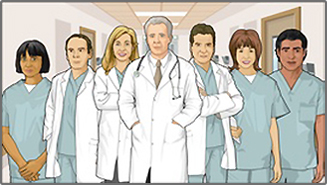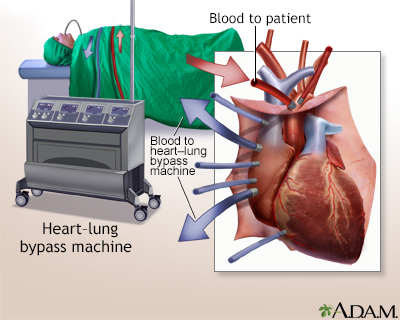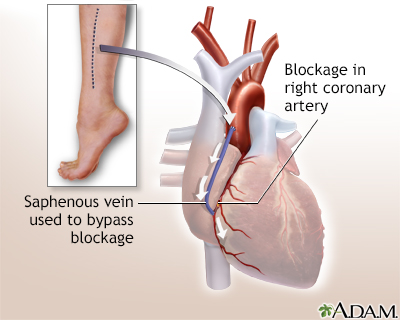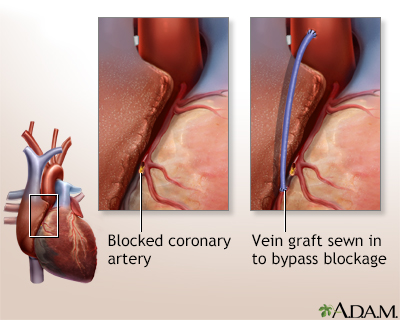Heart bypass surgery
Heart bypass surgery creates a new route, called a bypass, for blood and oxygen to go around a blockage to reach your heart.
Video Transcript
Heart bypass surgery - Animation
Heart bypass surgery creates a new route, called a bypass, for blood and oxygen to reach the heart. Heart bypass surgery begins with an incision in the chest, and the breastbone is cut exposing the heart. Next, a portion of the saphenous vein, which is very large, is harvested from the inside of the leg. Pieces of this large vein are used to bypass the blocked coronary arteries, which are arteries that supply blood to the heart. The venous graft is sewn to the aorta, the main artery of the body, and to the affected coronary artery, to bypass the blocked site. The internal mammary artery from the chest may also be used to bypass a clogged artery. Several arteries may be bypassed depending on the condition of the heart. After the graft is created, the breastbone and chest are closed.
Description
Before your surgery, you will get general anesthesia. You will be asleep (unconscious) and pain-free during surgery.
Once you are unconscious, most often, the heart surgeon will make an 8 to 10-inch (20 to 25 cm) surgical cut in the middle of your chest. Your breastbone will be separated to create an opening. This allows your surgeon to see your heart and aorta, the main blood vessel leading from the heart to the rest of your body.
Most people who have heart bypass surgery are connected to a heart-lung bypass machine or bypass pump.
- Your heart is stopped while you are connected to this machine.
- This machine does the work of your heart and lungs while your heart is stopped for the surgery. The machine adds oxygen to your blood, moves blood through your body, and removes carbon dioxide.
Another type of bypass surgery does not use the heart-lung bypass machine. The procedure is done while your heart is still beating. This is called off-pump coronary artery bypass, or OPCAB.
During bypass surgery:
- The surgeon will take a vein or artery from another part of your body and use it to make a detour (or graft) around the blocked area in your artery. Your surgeon may use a vein, called the saphenous vein, from your leg.
- To reach this vein, a surgical cut will be made along the inside of your leg, between your ankle and groin. One end of the graft will be sewn to your coronary artery. The other end will be sewn to an opening made in your aorta.
- A blood vessel in your chest, called the internal mammary artery (IMA), can also be used as the graft. One end of this artery is already connected to a branch of your aorta. The other end is attached to your coronary artery.
- Other arteries can also be used for grafts in bypass surgery. The most common one is the radial artery in your wrist.
After the graft has been created, your breastbone will be closed with wires, or if a different approach was used that would be closed as well. These wires stay inside you. The surgical cut will be closed with stitches.
This surgery can take 4 to 6 hours or longer, particularly if other procedures are performed (such as heart valve surgery). After the surgery, you will be taken to the intensive care unit.
Video Transcript
Coronary artery bypass graft (CABG) - Animation
One option to treat the blocked coronary artery is a surgical procedure called coronary artery bypass grafting surgery. The procedure involves taking a section of blood vessel from elsewhere in the body, such as the leg, and grafting it onto a location on the heart, which allows blood to bypass the blocked portion of the coronary artery. The procedure begins with the surgeon making a cut in the leg and removing a section of vein. Both ends of the vein are tied-off in the leg and cut is closed. The blood circulation in the leg is not compromised because the leg has many other veins, which can take over circulation in the area of the removed vein. The surgeon will then divide the sternum, the bone that runs down the middle of the chest, exposing the chest cavity. The heart is then usually connected to a heart-lung machine, which takes over the work of the heart and lungs during the treatment. Once this is complete, the heart is stopped. The surgeon then locates the blocked coronary artery and attaches the section of vein taken from the leg to the aorta and to the coronary artery below the blocked segment of the artery. The surgeon may do as many bypasses on as many blocked coronary arteries as the patient needs. Once each bypass graft is placed, it is checked for leaks. Following this, the heart is restarted. Once the heart is beating again, the surgeon will remove the leads to the heart-lung machine and sew the openings closed. Following this the chest is closed. The surgeon will leave pacemaker wires in the heart and bring them out to the skin to help control any heart rhythm problems the patient may have.
Why the Procedure Is Performed
You may need this procedure if you have a blockage in one or more of your coronary arteries. Coronary arteries are the vessels that supply your heart with oxygen and nutrients that are carried in your blood.
When one or more of the coronary arteries becomes partly or totally blocked, your heart does not get enough blood. This is called ischemic heart disease, or coronary artery disease (CAD). It can cause chest pain (angina).
Angina
Angina is a type of chest discomfort or pain due to poor blood flow through the blood vessels (coronary arteries) of the heart muscle (myocardium). ...

Coronary artery bypass surgery can be used to improve blood flow to your heart. Your health care provider may have first tried to treat you with medicines. You may have also tried exercise and diet changes, or coronary artery angioplasty with stenting.
Diet changes
A healthy diet is an important factor in reducing your risk for heart disease.

CAD is different from person to person. The way it is diagnosed and treated will also vary. Heart bypass surgery is just one type of treatment.
Other procedures that may be used:
- Angioplasty and stent placement
Angioplasty and stent placement
Angioplasty is a procedure to open narrowed or blocked blood vessels that supply blood to the heart. These blood vessels are called the coronary art...
 ImageRead Article Now Book Mark Article
ImageRead Article Now Book Mark Article - Heart bypass surgery - minimally invasive
Heart bypass surgery - minimally invasi...
Heart bypass surgery creates a new route, called a bypass, for blood and oxygen to reach your heart. Minimally invasive coronary (heart) artery bypas...
 ImageRead Article Now Book Mark Article
ImageRead Article Now Book Mark Article
Risks
Risks for any surgery include:
- Bleeding
- Infection
- Death
Possible risks from having coronary bypass surgery include:
- Infection, including chest wound infection, which is more likely to happen if you are obese, have diabetes, or have already had this surgery
- Heart attack
- Stroke
- Heart rhythm problems
- Kidney failure
- Lung failure
- Depression and mood swings
- Low fever, tiredness, and chest pain, together called postpericardiotomy syndrome, which can last up to 6 months
- Memory loss, loss of mental clarity, or "fuzzy thinking"
Before the Procedure
Tell your surgeon or nurse if you are taking any medicines, including medicines, drugs, supplements, or herbs you bought without a prescription.
During the week before your surgery:
- You may be asked to temporarily stop taking medicines that keep your blood from clotting. These medicines are called blood thinners. This includes over-the-counter medicines and supplements such as aspirin, ibuprofen (Advil, Motrin), naproxen (Aleve, Naprosyn), and vitamin E. Many prescription medicines are also blood thinners.
- Ask your surgeon which medicines you should still take on the day of surgery.
On the day of surgery:
- Follow instructions about when to stop eating and drinking.
- Take the medicines your surgeon told you to take with a small sip of water.
- Arrive at the hospital on time.
After the Procedure
After the operation, you will spend 3 to 7 days in the hospital. You will spend the first night in an intensive care unit (ICU). You will probably be moved to a regular or transitional care room within 24 to 48 hours after the procedure.
Two to three tubes will be in your chest to drain fluid from around your heart. They are most often removed 1 to 3 days after surgery.
You may have a catheter (flexible tube) in your bladder to drain urine. You may also have intravenous (IV) lines for fluids. You will be attached to machines that monitor your pulse, temperature, and breathing. Nurses will constantly watch your monitors.
You may have several small wires that are connected to a pacemaker, which are pulled out prior to your discharge.
You will be encouraged to restart some activities and you may begin a cardiac rehabilitation program within a few days.
It takes 4 to 6 weeks to start feeling better after surgery. Your providers will tell you how to take care of yourself at home after the surgery.
Take care of yourself at home
Heart bypass surgery creates a new route, called a bypass, for blood and oxygen to go around one or more blockages in the coronary arteries to reach ...

Outlook (Prognosis)
Recovery from surgery takes time. You may not see the full benefits of your surgery for 3 to 6 months. In most people who have heart bypass surgery, the grafts stay open and work well for many years.
This surgery does not prevent the coronary artery blockage from coming back. You can do many things to slow this process down, including:
- Not smoking
- Eating a heart-healthy diet
- Getting regular exercise
- Treating high blood pressure
- Controlling high blood sugar (diabetes) and high cholesterol
- Taking your medicines as prescribed
Reviewed By
Michael A. Chen, MD, PhD, Associate Professor of Medicine, Division of Cardiology, Harborview Medical Center, University of Washington Medical School, Seattle, WA. Also reviewed by David C. Dugdale, MD, Medical Director, Brenda Conaway, Editorial Director, and the A.D.A.M. Editorial team.
Doenst T, Taggart D, Gaudino MFL. Coronary artery bypass grafting. In: Sellke FW, del Nido PJ, Swanson SJ, eds. Sabiston and Spencer Surgery of the Chest. 10th ed. Philadelphia, PA: Elsevier; 2024:chap 91.
Lawton JS, Tamis-Holland JE, Bangalore S, et al. 2021 ACC/AHA/SCAI guideline for coronary artery revascularization: a report of the American College of Cardiology/American Heart Association Joint Committee on Clinical Practice Guidelines. Circulation. 2022;145(3):e18-e114. PMID: 34882435 pubmed.ncbi.nlm.nih.gov/34882435/.
Morrow DA, de Lemos JA. Stable ischemic heart disease. In: Libby P, Bonow RO, Mann DL, Tomaselli GF, Bhatt DL, Solomon SD, eds. Braunwald's Heart Disease: A Textbook of Cardiovascular Medicine. 12th ed. Philadelphia, PA: Elsevier; 2022:chap 40.
Teirstein PS, Kirtane AJ. Interventional diagnosis and treatment of coronary artery disease. In: Goldman L, Cooney KA, eds. Goldman-Cecil Medicine. 27th ed. Philadelphia, PA: Elsevier; 2024;chap 59.


















